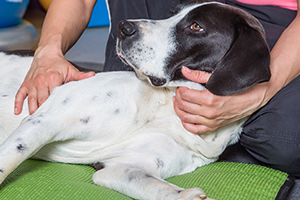
An athletic and versatile breed who just wants to have fun
Vital stats
Swipe to view more
| Size: | Medium to large |
| Coat: | Medium length, requires grooming once a week |
| Exercise | 2+ hours a day |
| Life span: | 11+ years |
| Breed group: | Gundog |
| Temperament: | Cheerful, attentive, energetic |
English Springer Spaniel temperament & personality

- Attentive and affectionate, English Springer Spaniels make wonderful family pets and do well with children.
- Despite their working background, Springers tend to get on well with other pets, apart from birds who they will instinctively hunt.
- These people-loving dogs will welcome strangers and expect attention from everyone!
- Springer Spaniels relish your company and shouldn’t be left alone for long.
English Springer Spaniel training & exercise

Training tips
- Eager to please and highly intelligent, Springers tend to be easy to train.
- Food is a great motivator so be sure to have some training treats at the ready.
- This playful breed will also respond well to toys as a motivator.
- Springers are easily bored so a long, repetitive training session will be counterproductive. Keep sessions to five to ten minutes at a time.
Keeping them happy
- Springers don’t like being left alone and may make their anxiety known by nuisance barking.
- Your Springer will love being outside, but make sure your garden is securely fenced to avoid any escape attempts.
- Because they are “always on” Springer Spaniels get bored easily, so make sure walks and playtime are varied.
Exercise
- Springer Spaniels need at least two hours of physical exercise every day.
- Springers also love to swim and this is a great way for them to keep fit and protect their joints.
- This is an extremely intelligent breed so plenty of mental stimulation is important to keep your dog’s mind in top condition.
Game ideas
- Springer Spaniels are always raring to go and excel at agility training where they can expend some energy and show off their new tricks at the same time.
Common English Springer Spaniel health conditions

English Springer Spaniel grooming

Waterproof, weatherproof and thornproof, a Springer’s coat is nothing if not multi-functional!
- Springers have a double coat meaning they have a shorter, insulating undercoat and a long, wavy top coat.
- This is a moderate shedding breed so be prepared for fairly regular grooming.
- To maintain a healthy, tangle-free coat, brush your Springer Spaniel two or three times a week, paying special attention to their feathery ears, chest and legs.
- Also use grooming time to check for lumps and bumps, as well as any ear problems which Spaniels can be prone to.
English Springer Spaniel nutrition

English Springer Spaniels tend to be easy when it comes to feeding time and are not fussy.
- Their high-energy personalities require a protein-packed diet.
- Springers love to chew so dry food is recommended. This will also help to keep their teeth clean and healthy.
- Divide feeding times into two meals per day.
What to know before you buy or rehome an English Springer Spaniel

Considering welcoming a bouncy and bubbly Springer Spaniel into your home? Before you buy or adopt one, here are a few important things to remember.
- Springer Spaniels tend to get on well with other dogs and pets, but are not suitable for households where birds are kept.
- Springers are highly intelligent and energetic and need plenty of exercise, stimulation and variety in their lives.
- This is a breed who gets bored easily and leaving them alone for long periods may cause separation anxiety as well as destructive and disruptive behaviours.
- Choose a licensed and reputable English Springer Spaniel breeder if you’re buying a puppy. ‘Lucy’s Law’ dictates that new puppies or kittens must be bought directly from a breeder or adopted from rescue. Third party sellers are illegal.
- Like all dogs, English Springer Spaniels can suffer from a range of health conditions so always look carefully at the veterinary cover provided when shopping around for pet insurance as not all policies are the same.
English Springer Spaniel frequently asked questions
Discover some of the most popular dog breeds
English Springer Spaniel insurance considerations
We always offer these things as standard:
Physiotherapy & pet therapies
Along with physiotherapy, which is covered within the Vet Bills benefit, we also cover Pet Therapies like herbal medicine, homeopathy and acupuncture. You can also claim for hydrotherapy, up to £500 per illness/injury in dogs and cats (no additional limit for rabbits).
Petplan is a trading name of Pet Plan Limited (Registered in England No. 1282939) and Allianz Insurance plc (Registered in England No. 84638), Registered office: 57 Ladymead, Guildford, Surrey GU1 1DB.
Pet Plan Limited is authorised and regulated by the Financial Conduct Authority. Financial Services Register No. 311969. Allianz Insurance plc is authorised by the Prudential Regulation Authority and regulated by the Financial Conduct Authority and the Prudential Regulation Authority. Financial Services Register No. 121849. Pet Plan Limited is a subsidiary of Allianz Insurance plc.


















































